Comparative Balance Sheet Format in Excel, PDF
Vyapar creates accurate comparative balance sheets automatically. Save time & avoid mistakes.
⚡️ Eliminate errors with pre-defined formulas
⚡ Simplify calculations and save time
⚡️ Generate accurate balance sheets in minutes
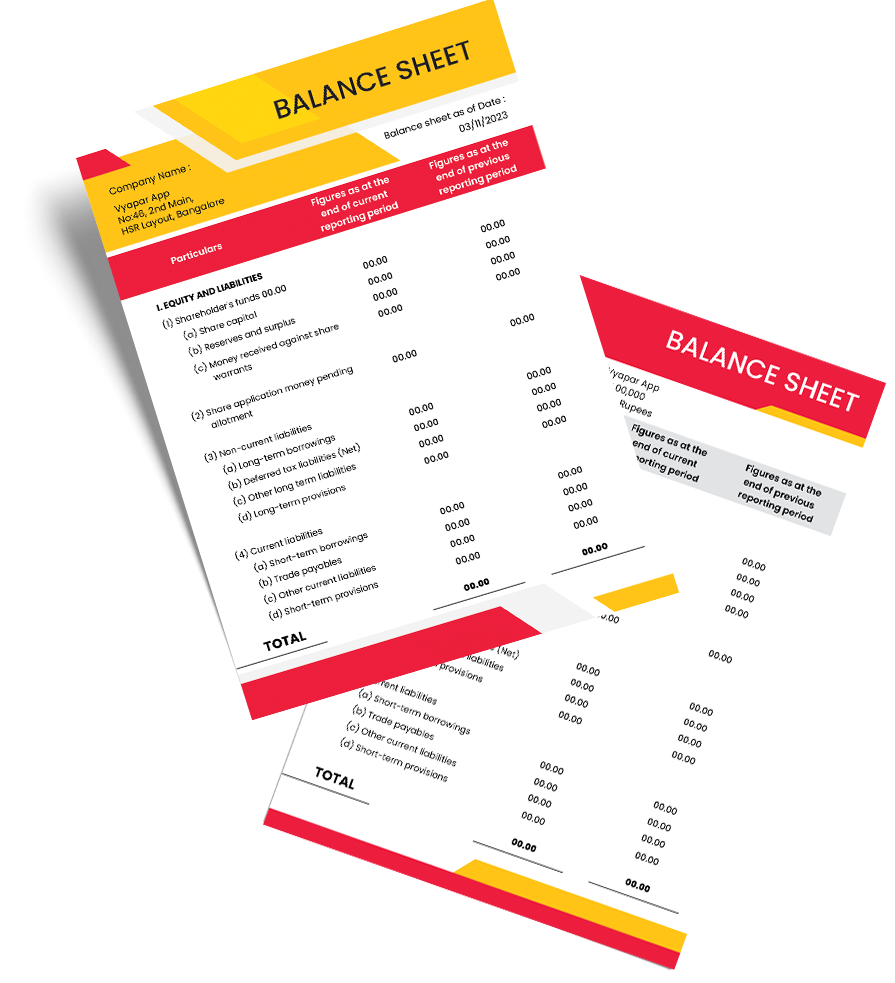
Download Free Comparative Balance Sheet Format
Download the comparative balance sheet format in Excel, PDF and customize according to your requirements at zero cost.
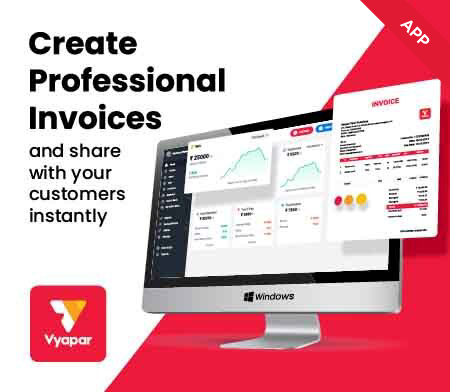
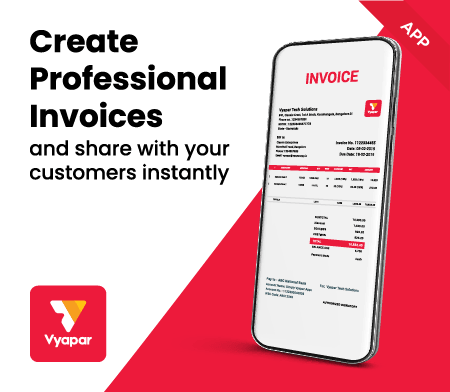
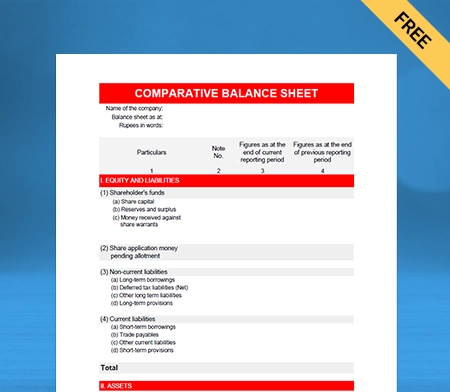
Comparative Balance Sheet Format – I
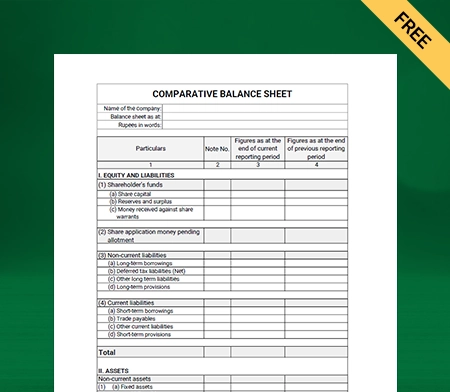
Comparative Balance Sheet Format – II
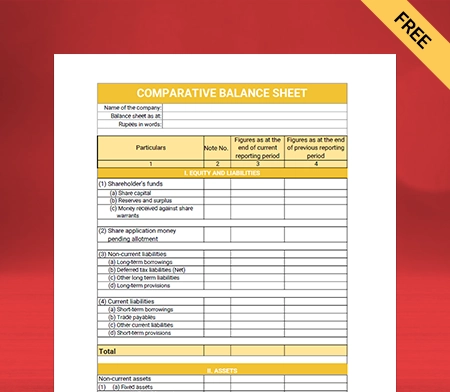
Comparative Balance Sheet Format – III
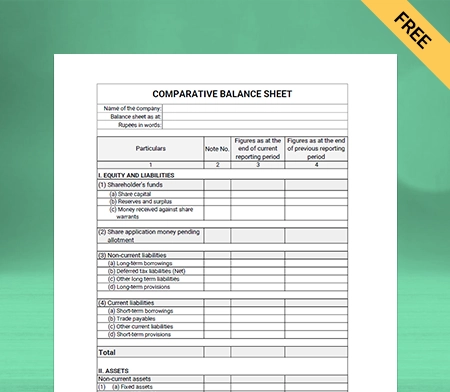
Comparative Balance Sheet Format – IV
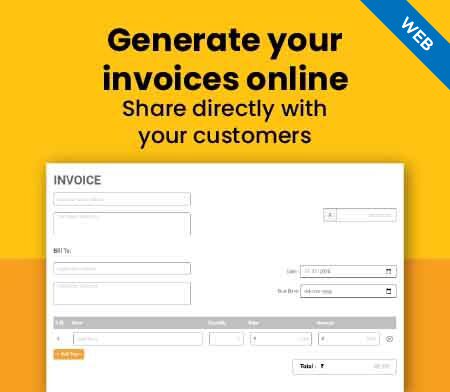
Generate Invoice Online
Highlights of Comparative Balance Sheet Format
We’ve put in a lot of effort to make sure you get the best template possible

All versions are print friendly

Built from scratch

Include essential invoice elements

Automatically calculate subtotal & grand total amount

Consistently formatted
What is a Comparative Balance Sheet?
A Comparative Balance Sheet is a statement showing the financial position of an entity for “two or more periods of the same company” or “two or more companies of the same industry” to compare the change, analyze the situation, and take appropriate action. It helps investors and stakeholders to compare, analyze and understand the company’s performance and trends and assists them in decision making.
The line items included in the format of comparative balance sheet are the same as in an individual balance sheet involving assets, liabilities, and equity. The classifications are further broken into current assets, current assets, and long-term liabilities.
How does Comparative Balance Sheet work?
The comparative balance sheet has two amount columns against each balance sheet item. One column shows the current year’s financial position, whereas the other column shows the previous year’s financial situation.
Businesses with different verticals prepare a comparative balance sheet compared to other verticals. The items are placed in rows, while years and amounts are shown in the columns in the comparative balance sheet pdf and excel.
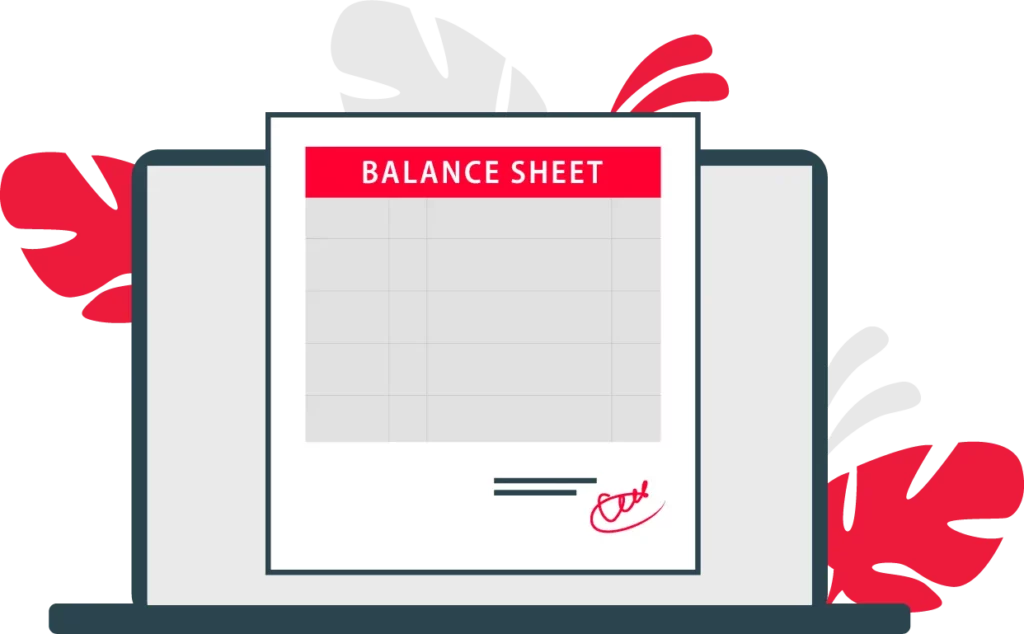
The content of balance sheets can vary based on industry and the unique financial condition of a business, but here are some common steps for how to make comparative balance sheet:
- Choose the reporting dates you want to compare. A reporting date is a date on which a balance sheet reports the assets, liabilities, and equity of a business at a particular point in time.
- Record all the assets or items of value your business owned in a table for each reporting date. Ensure the table includes current assets, total current assets, fixed assets, and total assets.
- Record all the liabilities or debts your company owed in the same table for each reporting date. The table must include current liabilities, total current liabilities, long-term liabilities, total long-term liabilities, and total liabilities.
- Record the shareholders’ equity in the same table for each reporting date. Shareholders’ equity is the difference between a company’s total assets and total liabilities, or its value after paying all its debts. You can calculate equity with this formula: Equity = Assets – liability.
- The total liabilities and owner’s equity aggregate should always equal the total assets. If it doesn’t, there may be an error somewhere. This financial report is called a balance sheet because your assets are balanced with the sum of liabilities and equity. The formula is Assets = liabilities + equity.
Why is Comparing balance sheets necessary?
Investors want to see evidence of your business’s financial performance in the past before they make investment decisions. You can show them a comparative balance sheet analysis to prove that your net worth has increased.
Comparing balance sheet format by Vyapar can help demonstrate potential issues in your business, and you can address them sooner. A public company can use the balance sheet comparison to fulfil requirements for listing on the stock exchange.
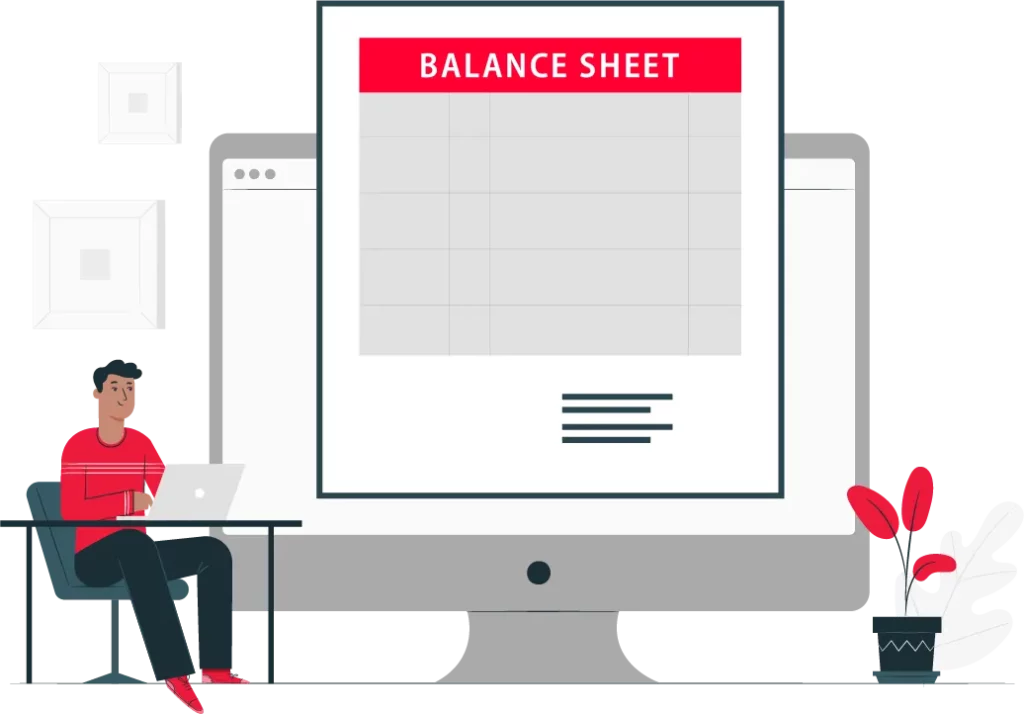
Comparative Statements can help a company track its debts over time and ensure it is paying them back timely. It also helps determine a company’s net worth, the owner’s or shareholders’ equity by subtracting total liabilities from total assets.
Stakeholders can calculate the balance sheet’s current ratio by dividing existing assets from current liabilities. The result measures the short-term financial risk of investing in a business.
Owners and investors can find the fixed asset turnover ratio by dividing a business’s net sales from its average fixed assets. It determines how much income a business gains from its assets and whether it manages assets efficiently.
You can calculate the return on assets ratio by dividing net income by average total assets; it shows how much income or profit a business earns from its assets.
Benefits of using Comparative Balance Sheet by Vyapar:
Comparison
With Vyapar’s Comparative Balance Sheet Format, the user can effortlessly compare the figures for the current year with previous years in one place. You can also analyze the data of two or more subsidiaries of one company or two or more different companies. The comparative statements show figures and numbers side by side.
Trend Indicator
The comparative balance sheets help to ascertain the company’s trend by putting figures from different periods in one place. It can help you identify the weaknesses and strengths of your entity. You can compare increases and decrease in profits, current assets, current liabilities, loans, and understand the seasonal fluctuations and make better-informed decisions.
Ratio Analysis
Financial ratios derive from the balance sheet, so comparative balance sheets by the Vyapar app provide you with ratios of different years like the current or liquidity ratios. Comparative financial statements help measure important financial ratios, which are used to predict the business’s financial health and overall performance.
Helps in Forecasting
Comparative Statements also help in forecasting as it provides the past trend of the business. Based on comparisons, management can forecast a company’s financial position by projecting material changes in your company. It’s essential to keep the balance sheet forecast in mind to build your financial model.
Help to make relevant decisions
It can be challenging to track the organization’s finances and manage everything simultaneously. With the help of the comparative balance sheet maker app, you can get an overview of your sales and expenses. The app will automatically update the data as soon as you edit a deal or cost, which will help you in making relevant decisions.
Features of the Vyapar App
Business Management
If you keep track of your financial records and compare records of different terms, you can identify any issues beforehand and avoid future problems. It also helps your company to stay flexible and adopt change with time. A comparative balance sheet format by Vyapar ensures that your business optimizes its strengths at the maximum level. Small businesses often neglect the importance of comparison, which causes significant issues.
Data Safety and Security
The Vyapar app is an entirely secure and hassle-free auto backup and manual backup system. It provides transaction-level passwords for editing and deleting and passcodes for software. Each transaction done through the app is safe, as even the app cannot access your information without your permission. It will encrypt your data with added security. You don’t have to fear losing anything after enabling the auto-backup mode.
Manage Commodities
The auto stock management feature of the Vyapar app ensures the availability of all required items. You can easily track and compare sales/purchase orders, stock inventory based on expiry, and other individual item attributes. The free balance sheet software by Vyapar facilitates the option to adjust stock manually and add new items as per requirement. With the use of this app, it is pretty simple to generate the bills within a few minutes, which is quite helpful for fulfilling the orders quickly.
Generates Reports
Companies must make healthy and informed decisions with the best reports. The data collected in the Vyapar app can help you make reports to analyze different metrics. The data is enabled with the balance sheet, increasing the company’s operational efficiency. This app analyzes accurate company details for different time intervals and provides formats for comparative balance sheets. You can quickly get to know the things that are doing good and those that need your attention.
Utilities
Most businesses today have automated preparing a comparative balance sheet using accounting software. Using the best accounting software of Vyapar, you can transfer all the data to the tally software. You can draw the comparative analysis and will have great flexibility to choose the period (Weekly, monthly, half-yearly, etc.) you want to compare rather than the comparative statements only for a financial year. You can also compare all the different reports across other companies.
Create your first invoice with our free Invoice Generator
Frequently Asked Questions (FAQs’)
The comparative analysis enables the management to locate the problems. It helps them put various budgetary controls and corrective measures to check whether the current performance aligns with the planned targets.
Comparative balance sheets provide users with a minimum of three data periods from prior accounting periods. They help provide the context needed to make the most informed business decisions by helping to identify trends.
Using the Vyapar app, you can stand out among competitors with an appealing increased efficiency. Further, you can track down paid and unpaid invoices and send payment reminders to the customers directly from the app.
No. You cannot access the Vyapar app on iOS, but you can use it on Android and desktop devices.
Yes. You can synchronize mobile data with a desktop by enabling the “Auto Sync” option.
The balance sheet is available in the Reports section of the Mobile and Desktop apps.
You can find the option “export to Tally” under utilities in the main menu.
To calculate a comparative balance sheet, follow these steps:
1. Select two periods for comparison.
2. Gather balance sheet data for both periods.
3. Calculate changes in each item.
4. Present data in a comparative format.
Vyapar can simplify this process with its user-friendly features and automated calculations, making financial analysis easier.
Here’s a step-by-step guide on how to prepare one:
1. Collect Statements: Gather balance sheets for the periods to compare.
2. List Assets: Create columns for assets for each period.
3. List Liabilities & Equity: Add columns for liabilities and equity.
4. Calculate Changes: Compute changes in each item from period to period.
The formula for calculating changes in individual items on a comparative balance sheet is straightforward:
Change=Current Year Amount−Previous Year Amount
This formula helps determine how each asset, liability, and equity item has changed from one period to another, providing valuable insights into the company’s financial performance and position over time.
Here’s a structured approach to writing such an analysis:
1. Introduction: Briefly explain why you’re comparing the balance sheets.
2. Overview: Describe the periods being compared (e.g., two consecutive years).
3. Key Metrics: Identify the financial metrics you’re analyzing (e.g., assets, liabilities).
4. Changes Analysis: Use the formula
5. Change=Current Year Amount−Previous Year Amount
6. Change=Current Year Amount−Previous Year Amount to calculate changes and explain significant differences.
7. Conclusion: Summarize the main trends and insights from the analysis.
A comparative balance sheet shows changes in a company’s financial position over multiple periods, aiding in trend analysis and performance evaluation.
To solve a comparative balance sheet:
1. Collect balance sheets for the periods you’re comparing.
2. Create columns for assets, liabilities, and equity for each period.
3. Calculate changes by subtracting previous period amounts from current ones.
4. Analyze changes to understand financial trends and implications.
5. Summarize findings, highlighting significant changes.
The main objective of a comparative balance sheet is to compare a company’s financial position over time, helping stakeholders assess trends, evaluate performance, monitor stability, and make informed decisions.
A comparative balance sheet compares a company’s financial position over different periods, showing absolute amounts. In contrast, a common-size balance sheet presents financial data as percentages of total assets, making it easier to compare components’ relative importance across periods.




